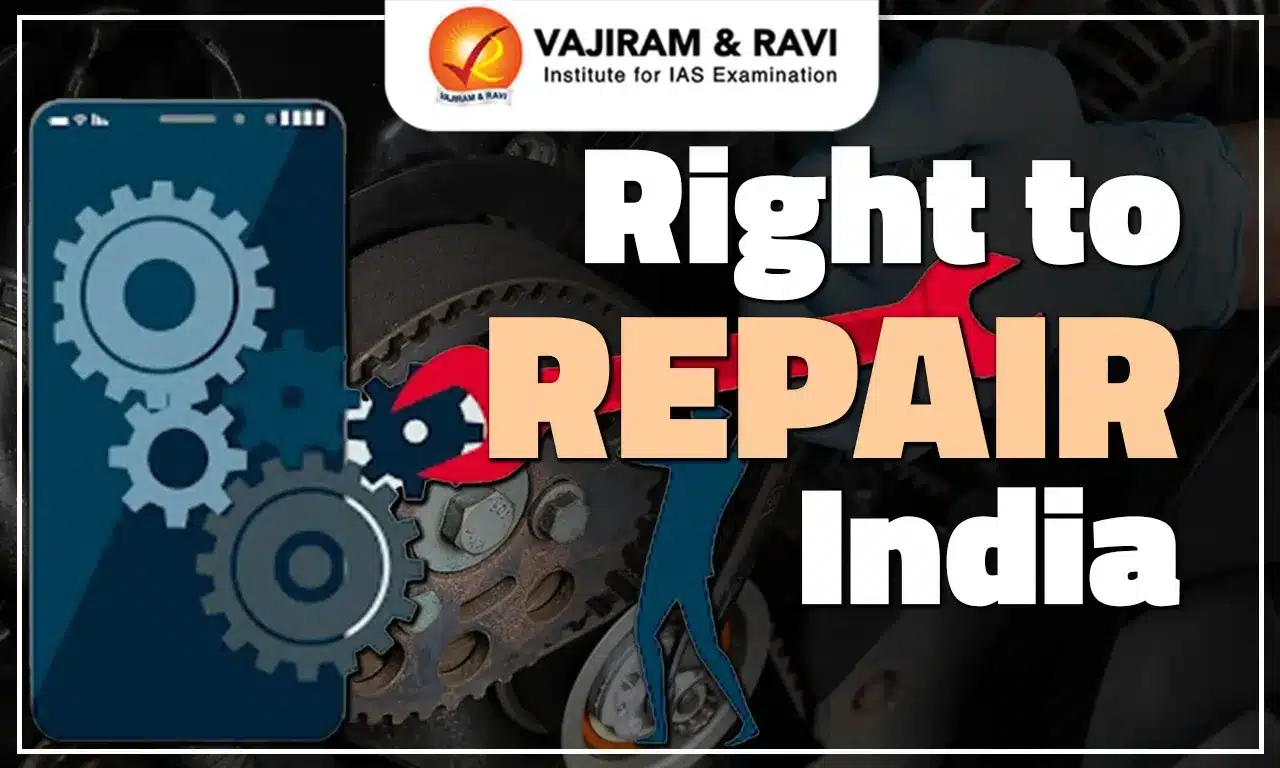What’s in Today’s Article?
- Right to Repair Latest News
- Introduction
- Understanding the Repairability Index
- The Need for Repairable Electronics
- The Right to Repair Movement in India
- Global Context and U.S. Comparison
- Challenges Ahead
- Right to Repair India FAQs
Right to Repair Latest News
- The Department of Consumer Affairs (DoCA) recently announced that a report for a “Framework on Repairability Index (RI) in Mobile and Electronic Sector” had been submitted to the government.
Introduction
- India has taken a notable step toward empowering consumers and ensuring environmental sustainability through its Right to Repair movement.
- The Department of Consumer Affairs (DoCA) recently accepted a report on the proposed Repairability Index (RI)for mobile phones and electronic appliances, which aims to rank products based on how easy they are to repair.
- This framework, aligned with the global right to repair movement, is a response to rising concerns about product durability, electronic waste, and consumer dependence on manufacturers for repairs.
Understanding the Repairability Index
- The proposed Repairability Index is a score that evaluates how easy it is to repair a product. It considers criteria such as:
- Availability and pricing of spare parts
- Access to repair documentation
- Cost and time of repairs
- Software support (e.g., updates)
- Consumer electronic products and appliances like smartphones, washing machines, and refrigerators would be rated using this index, allowing consumers to make informed purchase decisions.
- The idea is to promote long-lasting products and provide transparency regarding repair options.
The Need for Repairable Electronics
- The initiative comes amid increasing complaints that modern appliances break down more often than older ones.
- This is partly due to planned obsolescence, where companies deliberately manufacture products with a shorter lifespan to push consumers to buy new ones.
- The declining metal content in appliances (due to rising metal prices and competition) has also contributed to poor durability. India’s reliance on imported metals like copper further exacerbates the problem.
- Prolonging the lifespan of electronics also ties into India’s broader goals like:
- Reducing electronic waste (e-waste)
- Supporting a circular economy where old parts re-enter the value chain
- Lowering the demand for freshly mined (“virgin”) metals
The Right to Repair Movement in India
- Globally, the right to repair refers to the consumer’s ability to choose how and where to repair their devices, whether through the manufacturer or independent service providers.
- In India, the DoCA launched a Right to Repair Portal, listing:
- Manufacturer-authorized service centres
- Repair manuals and guides
- Unlike the more confrontational stance in countries like the U.S., India’s model currently supports manufacturer-authorized channels, with limited support for third-party repairs.
- However, the inclusion of consumer rights advocates suggest the framework may not be entirely in favour of manufacturers.
- They emphasized that denying repair services for older products violates the consumer’s right to choice and advocated for more repair freedom.
Global Context and U.S. Comparison
- In the United States, the Right to Repair movement has gained legislative support, especially against practices like:
- Restricting access to spare parts
- Locking devices with proprietary software
- Penalizing third-party repairs
- Laws have been introduced requiring companies to publish repair costs and ensure access to spare parts. In contrast, Indian policy is still evolving, with more collaboration between the government and manufacturers.
- One notable example is McDonald’s in the U.S., where only Taylor Company technicians are allowed to repair the brand’s ice cream machines, leading to consumer frustration and regulatory scrutiny.
- Similar monopolistic repair models in electronics are being questioned globally.
Challenges Ahead
- Though India’s Repairability Index is a progressive move, it faces several challenges:
- Balancing innovation and industry freedom with consumer rights
- Overcoming resistance from electronics manufacturers who profit from repair services
- Creating enforcement mechanisms to ensure compliance
- Making third-party repairs safe and reliable
- Moreover, the committee drafting the RI consisted mostly of industry representatives, which may influence the eventual shape of the policy.
Right to Repair India FAQs
Q1. What is the Repairability Index in India?
Ans. It is a proposed score that rates electronic products based on how easy they are to repair.
Q2. What does the Right to Repair movement advocate?
Ans. It seeks to give consumers greater freedom to repair their products through authorized or third-party services.
Q3. How is India’s Right to Repair approach different from the U.S.?
Ans. India promotes a collaborative approach with manufacturers, while the U.S. has adopted a more regulatory stance.
Q4. Why is the Right to Repair important for consumers?
Ans. It helps consumers save money, extend product lifespans, and reduce e-waste.
Q5. What are the challenges in implementing the Repairability Index?
Ans. Key challenges include resistance from manufacturers, industry lobbying, and the need to balance consumer rights with business innovation.
Source: TH
Last updated on June, 2025
→ UPSC Notification 2025 was released on 22nd January 2025.
→ UPSC Prelims Result 2025 is out now for the CSE held on 25 May 2025.
→ UPSC Prelims Question Paper 2025 and Unofficial Prelims Answer Key 2025 are available now.
→ UPSC Calendar 2026 is released on 15th May, 2025.
→ The UPSC Vacancy 2025 were released 1129, out of which 979 were for UPSC CSE and remaining 150 are for UPSC IFoS.
→ UPSC Mains 2025 will be conducted on 22nd August 2025.
→ UPSC Prelims 2026 will be conducted on 24th May, 2026 & UPSC Mains 2026 will be conducted on 21st August 2026.
→ The UPSC Selection Process is of 3 stages-Prelims, Mains and Interview.
→ UPSC Result 2024 is released with latest UPSC Marksheet 2024. Check Now!
→ UPSC Toppers List 2024 is released now. Shakti Dubey is UPSC AIR 1 2024 Topper.
→ Also check Best IAS Coaching in Delhi
























